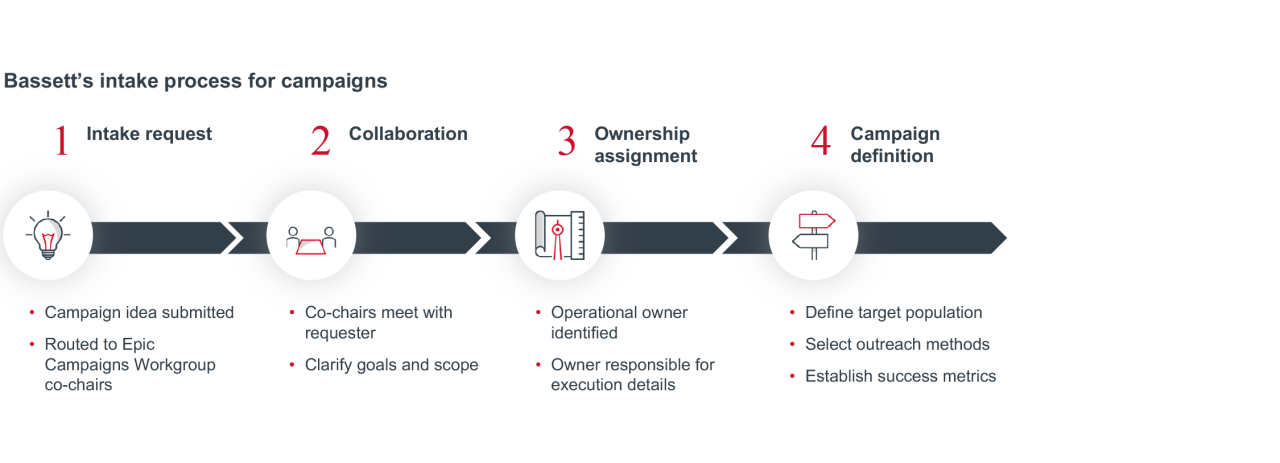Bassett Medical Group used Epic Cheers - Campaigns to personalize and streamline patient outreach. The collaboration achieved measurable success in diabetes management, breast cancer screenings, and flu vaccinations. The three-step approach that Bassett took — creating multidisciplinary teams, ensuring campaigns match organizational readiness, and assigning initiative ownership — offers an approach for improving overall population health and patient engagement.
The challenge
Bassett Medical Group set out to improve patient outreach for a diverse patient population and address persistent gaps in preventive care, chronic disease management, and vaccination coverage. Executing effective campaigns requires the alignment of organizational resources, clear communication, and tailored outreach to meet the needs of different patient groups. These efforts are vital for improving access to care and supporting population health efforts.
The organization
Bassett Medical Group is a comprehensive healthcare network based in Central New York, serving communities across eight counties. It is anchored by Bassett Medical Center, a 180-bed acute care teaching hospital in Cooperstown and includes primary and specialty care, outpatient clinics, and long-term care facilities. Bassett prioritizes rural healthcare delivery and combines innovative medical practices with community-focused care. Bassett also supports medical education and research through its affiliation with Columbia University.
The approach
Bassett sought to modernize its patient outreach and engagement by replacing its defunct patient engagement platform with Epic Cheers - Campaigns. With support from Optum Advisory, Bassett implemented Epic Cheers - Campaigns to run targeted, measurable campaigns from within its electronic health record (EHR). The transition to Epic Cheers - Campaigns wasn’t just a system upgrade. It marked a fundamental shift in how Bassett had to structure and support its campaigns. To ensure successful execution, Bassett followed a three-step approach: forming a multidisciplinary team for streamlined decision-making, aligning campaigns with capacity and organizational needs, and setting up intake and implementation processes.
As part of the Epic Cheers product suite, Epic Campaigns allowed Bassett to coordinate and personalize messaging and marketing efforts using data from Epic systems. Epic Cheers - Campaigns acts as an omnichannel platform, which facilitates communication across diverse patient demographics, digital literacy levels, and varying degrees of familiarity with the organization.1 Outreach spanned MyChart messages, visit summaries, emails, texts, calls, and printed letters, helping ensure equitable access and reduce digital disparities.
The result
Bassett successfully executed campaigns that addressed uncontrolled diabetes, breast cancer screening, and flu vaccinations. These campaigns led to increased appointment scheduling, improved chronic disease management, early detection of breast cancer, and expanded vaccination coverage. For example, the breast cancer screening campaign led to 17 new cancer diagnoses and 757 imaging services delivered.2
Breast cancer diagnoses
Patients received imaging services
How Bassett used Epic for campaigns
Bassett Medical Group partnered with Epic to leverage the Cheers - Campaigns tool to improve patient outreach and engagement across various health initiatives. By integrating Epic's customer relationship management (CRM) capabilities, Bassett aimed to deliver targeted and measurable campaigns to address gaps in care.
Bassett Medical Group recognized the need for a systematic approach to successfully execute campaigns. The approach followed three key steps, listed below.
The three steps
To ensure campaigns delivered meaningful results, Bassett focused on initiatives that aligned with its strategic goals and fit within their existing capacity. The Epic Campaigns Workgroup evaluated each campaign request through the lens of organizational fit, considering whether the campaign supported broader population health objectives, addressed known care gaps, and aligned with available resources.
If any one of these three elements is missing, the campaign risks falling short. For example, even if a campaign is well-timed and strategically aligned, it will fail if the organization lacks the capacity to deliver services like screenings or appointments. Outreach without follow-through can lead to patient frustration and missed opportunities for care.
Assessing campaign initiatives for organizational fit
| Population health objectives | Known care gaps | Available organizational resources |
|---|---|---|
|
|
|
|
|
|
The most critical step in Bassett’s intake process was assigning an operational owner to each initiative. These owners defined the campaign’s target population and outreach methods. The Epic Campaigns Workgroup supported operational owners by helping to establish success metrics for each campaign, such as number of scheduled appointments, completed screenings or vaccinations, and new diagnoses resulting from outreach.
The team tracked progress using reporting tools within Epic and collected data by creating dashboards for each campaign. These dashboards supported ongoing reporting and could be shared to showcase current performance.
Operational owners facilitated regular alignment checks to ensure all participants understood campaign goals. These meetings helped stakeholders — including the chief marketing officer, chief medical information officer, head of the physician group, and physician champions — coordinate next steps before moving a campaign forward. Project teams intentionally paused campaigns whenever stakeholders felt disconnected or unclear about objectives. This allowed everyone to regroup and reinforce goals. For example, the campaign team for annual wellness visits paused to ensure appropriate inclusion criteria and meticulous planning, while the team focused on flu vaccinations staggered outreach to ensure sufficient capacity for visits.

Lastly, poor data quality can lead to ineffective outreach and alert fatigue among patients, causing important communications to be ignored. While Bassett did not require significant data cleanup prior to launching campaigns, successful workflows depended on having trustworthy data. Organizations new to Epic or with unclear workflows may need to invest in data quality improvements before starting similar initiatives.
How Bassett knows it’s working
Bassett Medical Group’s collaboration with Optum Advisory for Epic Cheers - Campaigns has led to patient engagement innovations. The results demonstrate the impact of more coordinated outreach, with measurable success across three distinct campaigns.
Uncontrolled diabetes campaign
Patients scheduled appointments, received diabetes management medication, or started using continuous glucose monitors
Patients achieved A1C levels below 9, demonstrating improved diabetes control
Breast cancer screening campaign
Patients identified with breast cancer through outreach efforts
Patients received imaging services, supporting early detection and preventive care initiatives
Flu vaccination campaign
Outreaches delivered to target populations
Patients either received flu shots at Bassett or updated records of vaccinations received externally
1 Overview of Cheers. Epic Systems Corporation. 2025.
2 Unless otherwise specified, all information in this case study came from Advisory Board interviews with officials from Bassett Medical Group.
Don't miss out on the latest Advisory Board insights
Create your free account to access 1 resource, including the latest research and webinars.
Want access without creating an account?
You have 1 free members-only resource remaining this month.
1 free members-only resources remaining
1 free members-only resources remaining
You've reached your limit of free insights
Become a member to access all of Advisory Board's resources, events, and experts
Never miss out on the latest innovative health care content tailored to you.
Benefits include:
You've reached your limit of free insights
Become a member to access all of Advisory Board's resources, events, and experts
Never miss out on the latest innovative health care content tailored to you.
Benefits include:
This content is available through your Curated Research partnership with Advisory Board. Click on ‘view this resource’ to read the full piece
Email ask@advisory.com to learn more
Click on ‘Become a Member’ to learn about the benefits of a Full-Access partnership with Advisory Board
Never miss out on the latest innovative health care content tailored to you.
Benefits Include:
This is for members only. Learn more.
Click on ‘Become a Member’ to learn about the benefits of a Full-Access partnership with Advisory Board
Never miss out on the latest innovative health care content tailored to you.



